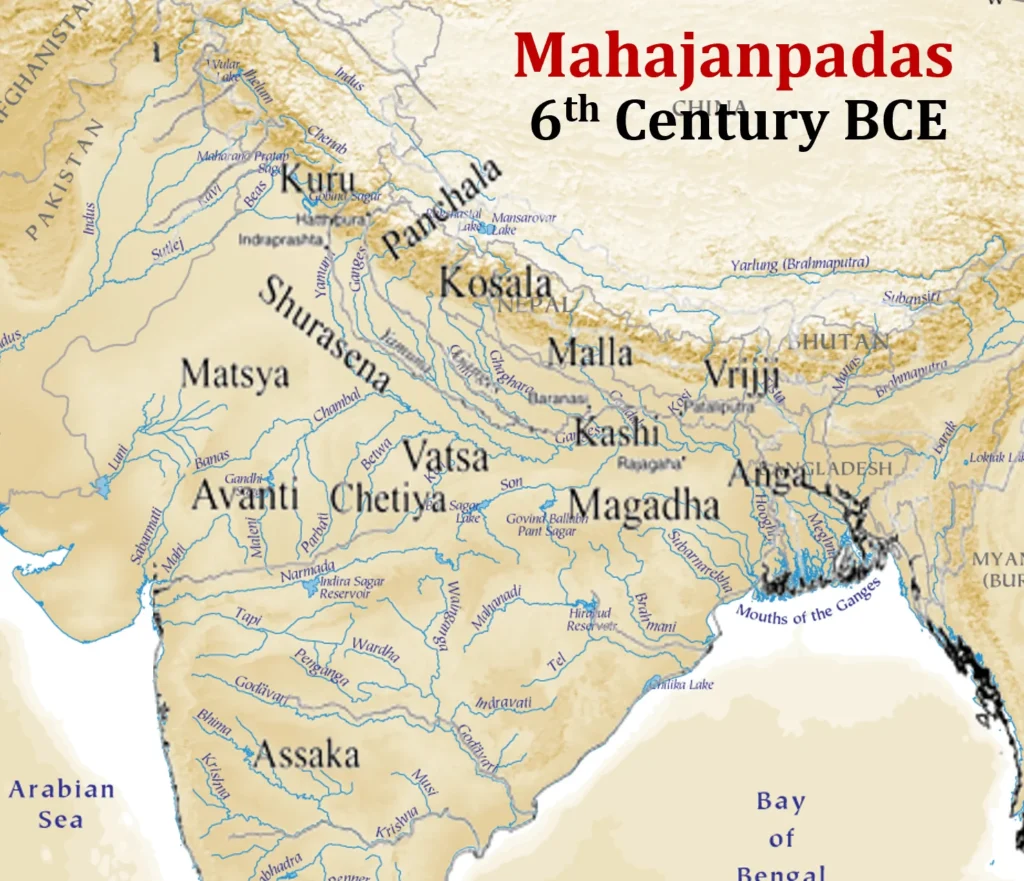
By the 6th century BC last Kingdom or Janapads were established in the entire northern plain of India, extending up to the northwestern region. The emergence of Mahajanpadas, a crucial phase in ancient India‘s history, marks the transition from tribal republics to organized kingdoms. This transformation significantly shaped the subcontinent’s political landscape.
Since the Mahajanpadas were crucial in shaping India’s political and sociocultural landscape, it is imperative to comprehend them. The history of the country has been permanently impacted by their rise and collapse.
We shall examine the definition of Mahajanpadas, their historical background, the circumstances behind their emergence, and an analysis of their traits in this blog article. We will also talk about the significance of the Arthashastra and Kautilya, the fall from grace of the Mahajanpadas, and its lasting influence.
What are Mahajanpadas?
Mahajanpadas were a group of kingdoms that emerged as a large kingdom. In ancient India during the 6th century BCE. These states were distinct from earlier tribal republics and marked a shift towards centralized authority. There were 16 Janapadas termed by the scholars as Mahajanapadas. Among the 16 Mahajanapadas, 11 were marked by the monarchy and five were republics (Gana).
Geographic distribution and diversity of Mahajanpadas
The geographic distribution and diversity of the Mahajanpadas were fundamental aspects of their historical significance and cultural richness. These 16 major kingdoms, which emerged in ancient India during the 6th century BCE were scattered across the Indian subcontinent, each with its unique culture, language, and governance systems. The political, economic, and cultural landscapes of these administrative entities evolved at that time had the impact of their locations and the associated variations.
In this exploration we will delve into these factors extensively.
- Wide Geographic Spread: The Mahajanpadas were spread across different regions of ancient India, encompassing a considerable portion of the subcontinent. These regions included:
- Magadha, which is now part of Bihar was a powerful Mahajanpada.
- Kosala, located in the northern region of India held great significance as a kingdom, with its capital situated at Shravasti.
- Vatsa: Vatsa was in the northern Gangetic plains, with its capital at Kausambi.
- Kashi: Also in the northern Gangetic plains, Kashi’s capital was Varanasi (Banaras).
- Anga: Anga was in the eastern region, around modern-day Bhagalpur.
- Avanti: Located in the western part of India, Avanti had its capital at Ujjain.
- Chedi: Chedi covered parts of modern-day Madhya Pradesh and Uttar Pradesh.
- Vajji (Vriji): This republic was located in the Mithila region.
- Malla: Situated in parts of modern-day Bihar and Uttar Pradesh.
- Gandhara: Gandhara extended into the northwestern regions, including parts of modern-day Afghanistan and Pakistan.
- Kuru: Kuru was in the northern Indian plains.
- Panchala: This kingdom was situated to the east of the Kurus.
- Kamboja: Kamboja covered parts of modern-day northern India, Pakistan, and Afghanistan.
- Assaka: Assaka was located in the southern Deccan region.
- Chola: The Chola Mahajanpada was located in the southern part of India, in what is now Tamil Nadu.
- Matsya: Matsya was situated in the northwestern part of India.
- Cultural and Linguistic Diversity: The geographic distribution of the Mahajanpadas also reflected the linguistic and cultural diversity of ancient India. Each kingdom had its own language, culture, and traditions. For example, Magadha in the east had strong ties to the Vedic culture, while the Kamboja Mahajanpadas in the northwest was influenced by Persian and Central Asian cultures. The southern Chola Mahajanpadas had a distinct Dravidian cultural influence.
- Economic Heterogeneity: The diverse geographical locations of these kingdoms influenced their economic activities. For instance, Mahajanpadas situated in the fertile Gangetic plains, like Magadha and Kosala, were primarily agrarian, relying on agriculture as a key economic activity. In contrast, the northwestern regions like Gandhara were strategically positioned along the Silk Road trade routes, facilitating trade and commerce. Coastal Mahajanpadas like the Chola had thriving maritime trade networks.
- Interactions and Conflicts: The diversity in geographical locations often led to interactions, alliances, and conflicts between these kingdoms. The regions were strategically important for trade, territorial expansion, and control of valuable resources. As a result, many Mahajanpadas engaged in diplomatic negotiations and military campaigns to protect their interests and assert their dominance.
The geographic distribution and diversity of the Mahajanpadas were central to their historical significance. These kingdoms, each with its own distinct culture, language, and economic endeavors, covered a wide and diverse territory. The political climate of ancient India was greatly influenced by their contacts and disputes in this multicultural setting. The intricate and dynamic nature of the ancient Indian civilization is demonstrated by this diverse tapestry of geographical and cultural elements.
Chronological development of Mahajanpadas
These kingdoms developed over time, with each Mahajanpada rising to prominence at different points in history. The chronological development of Mahajanpadas is a fascinating journey through ancient Indian history, marking the transition from tribal republics to organized kingdoms. These 16 major kingdoms emerged over time, each reaching prominence at different points in history. Here is a detailed exploration of the chronological development of Mahajanpadas:
- Early Tribal Republics (Pre-6th Century BCE):
- Before the rise of Mahajanpadas, ancient India was characterized by a plethora of tribal republics, small chiefdoms, and clans.
- These tribal societies were relatively localized, with limited centralized authority and often operated on the basis of kinship and common descent.
- The Vedic period (c. 1500-500 BCE) had a significant influence on the early political organization in ancient India, setting the stage for larger political entities.
- Emergence of Kingdoms (6th Century BCE):
- The 6th century BCE witnessed the transformation of tribal republics into organized kingdoms, marking the birth of the Mahajanpadas.
- Initially, these kingdoms were centered around powerful urban centers and gained prominence due to their control over resources, trade routes, and agrarian territories.
- Magadha, located in the fertile Gangetic plains, was one of the first Mahajanpadas to rise to prominence, under the leadership of the Haryanka dynasty.
- Continued Expansion (6th-4th Century BCE):
- During this period, more Mahajanpadas came into existence, often as a result of territorial expansion, dynastic conflicts, and political consolidation.
- The Kosala Mahajanpada, under the rule of King Mahakosala, became influential in northern India.
- The Vatsa Mahajanpada, located to the west of the Ganges, also gained prominence, with Kausambi as its capital.
- Other Mahajanpadas like Kashi, Anga, and Avanti emerged as significant political entities.
- Height of Mahajanpada Dominance (4th Century BCE):
- The 4th century BCE marked the zenith of Mahajanpada power, with these kingdoms exerting considerable influence over their respective regions.
- The Vajji (or Vriji) confederation was known for its republican form of government and held significant sway in the Mithila region.
- Major Mahajanpadas like Magadha, Kosala, and Vatsa were engaged in territorial expansion and conflicts, further consolidating their power.
- Diverse Regional Dynamics (4th-3rd Century BCE):
- During this period, some Mahajanpadas continued to thrive, while others faced decline and territorial losses due to internal and external factors.
- The southern Chola Mahajanpada flourished in Tamil Nadu, showcasing the geographic diversity of these kingdoms.
- Mahajanpadas like Kuru, Panchala, Kamboja, and Gandhara maintained their significance in various regions.
- Decline and the Mauryan Empire (3rd Century BCE):
- The 3rd century BCE witnessed the decline of the Mahajanpadas due to internal conflicts, external invasions, and economic challenges.
- Chandragupta Maurya’s rise to power and the subsequent formation of the Mauryan Empire marked the end of the Mahajanpada era.
- Magadha’s prominence continued as the Mauryan Empire established its dominance.
- Legacy (3rd Century BCE and Beyond):
- The Mahajanpadas left a lasting legacy in terms of administrative and political structures that influenced the Mauryan Empire and later empires in India.
- The Arthashastra, written by Kautilya (Chanakya), provides insights into the political and administrative systems of the Mahajanpadas and influenced subsequent Indian political thought.
The chronological development of Mahajanpadas reflects the dynamic and evolving political landscape of ancient India. These kingdoms emerged gradually, flourished for a time, and ultimately contributed to the foundation of more centralized and powerful empires. The era of Mahajanpadas is a significant chapter in India’s history, showcasing the transition from tribal republics to organized states.
Factors Leading to the Emergence of Mahajanpadas
- Economic factors
- Agriculture and trade: Economic activities such as agriculture and trade were instrumental in the growth of these kingdoms.
- Urbanization and commerce: The development of cities and increased trade fostered economic growth.
- Social factors
- Caste system and societal structure: The caste system played a role in defining social hierarchies within the Mahajanpadas.
- Role of Jana and Ganarajya: The concepts of Jana and Ganarajya (republics) influenced the political structure.
- Political factors
- Dynastic conflicts and consolidation of power: Rivalries among dynasties and their quest for power were driving forces.
- Expansionist policies and territorial disputes: Territorial expansion and disputes led to the unification of smaller regions.
The Mahajanpadas and Their Characteristics
Overview of major Mahajanpadas
Highlighting prominent Mahajanpadas like Magadha, Kosala, and Vatsa.
Kosala
A prominent position in the historical and cultural landscape of the Indian subcontinent was held by Kosala, one of the sixteen Mahajanapadas (great kingdoms or republics) of ancient India. With its capital in Shravasti, which is now in Uttar Pradesh, the kingdom of Kosala was situated in northern India. This is a summary of Kosala’s Mahajanapada.:
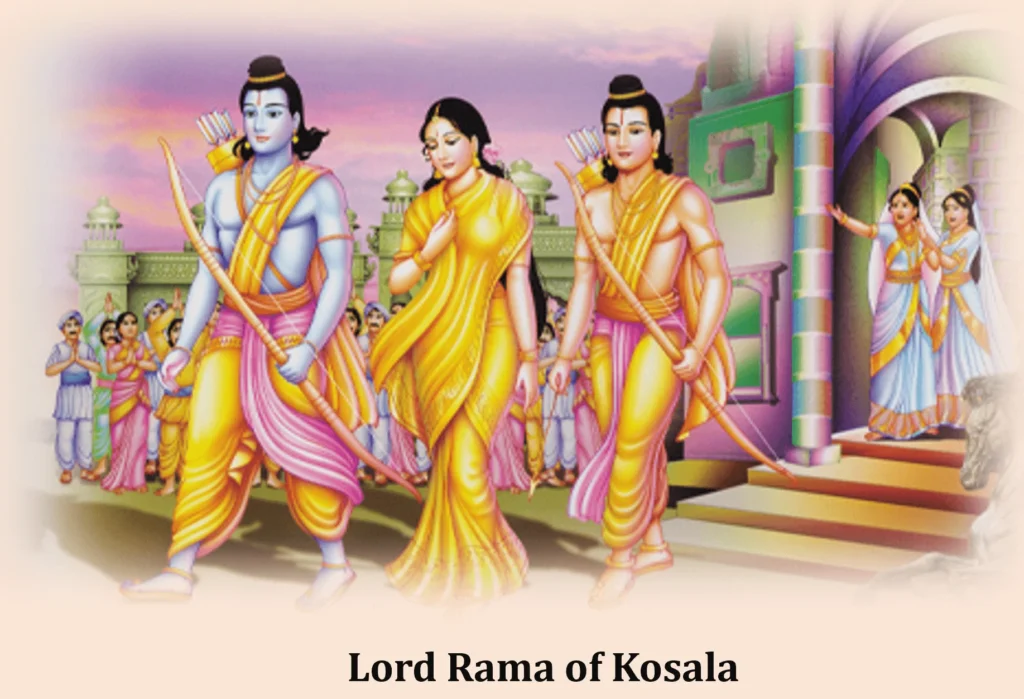
- Geographic Extent: Kosala was situated along the banks of the Sarayu River (modern-day Ghaghara River) in northern India. It covered a substantial territory in the Ganges-Yamuna Doab, making it one of the more influential and prosperous Mahajanapadas.
- Historical Significance: Kosala holds importance mainly because of its connection, to the ancient Indian epic, the Ramayana. According to this epic Ayodhya, which served as the capital of Kosala was the birthplace of Lord Rama, a deity in Hinduism. The Ramayana recounts the story of Lord Rama and his wife Sita chronicling their lives and adventures. It is highly regarded as one of the texts, in Indian mythology.
- Rulers: Kosala had a succession of prominent rulers, and one of the most famous among them was Mahakosala. His reign, during the 6th century BCE, is considered significant in the history of Kosala. Under his rule, the kingdom flourished, and it extended its influence over neighboring regions.
- Culture and Society: Kosala was known for its rich cultural and religious traditions. The religion of the Kosala people was Hinduism, and the area was home to many historic temples and holy places. Hindus especially regard the city of Ayodhya as the birthplace of Lord Rama and it is still a major pilgrimage site today.
- Political Dynamics: Kosala was involved in several conflicts and rivalries with neighboring Mahajanapadas, most notably with the Magadha kingdom. The power struggle between these regions played a crucial role in shaping the political landscape of ancient India. Eventually, Magadha emerged as a dominant force in the region, and Kosala was absorbed into the Magadha Empire.
- Decline: The decline of Kosala as an independent Mahajanapada occurred when Magadha, under the leadership of the Nanda dynasty, expanded its influence and subjugated various neighboring kingdoms, including Kosala. This marked the end of the independent Kosala kingdom, as it became a part of the larger Magadha Empire.
The historical significance of Kosala is intimately linked to its association with the Ramayana and its function in the political and cultural advancements of ancient India. The religious and cultural traditions of India, especially those of Hinduism, continue to honor and commemorate the heritage of this Mahajanapada.
Kashi
Kashi, also known as Varanasi was a kingdom or republic, among the sixteen Mahajanapadas of India. It held importance in terms of historical and cultural heritage, within the Indian subcontinent. An outline of Kashi’s Mahajanapada is provided below:
- Geographic Extent: Kashi was situated alongside the revered Ganges River in the area that now forms a portion of the state of Uttar Pradesh. The capital city of Kashi was Varanasi, which presently stands as one of the cities still inhabited in the world and holds immense religious and cultural significance.
- Historical Importance: Kashi holds religious significance being recognized as one of the seven sacred cities, in Hinduism and often referred to as “the spiritual capital of India.” Its age is testified by its mention in Indian texts like the Vedas, the Mahabharata and the Puranas.
- Religion and Spirituality: Kashi is renowned as a hub for Hindus. It is considered a sacred place believed to be Lord Shivas abode, who holds a position among Hindu deities. The city boasts temples, including the revered Kashi Vishwanath Temple dedicated to Lord Shiva attracting pilgrims and tourists from all corners of India and beyond. The ghats (riverfront steps) along the Ganges in Varanasi hold significance where diverse ceremonies take place, including the visually captivating and spiritually meaningful Ganga Aarti ritual.
- Trade and Commerce: Strategically positioned along the trade routes of the Ganges River Kashi facilitated thriving trade and commerce activities in its heyday. The city flourished economically. Played a role, in regional trade dynamics while fostering exchange of goods. The river acted as a mode of transportation enabling the movement of individuals and commodities.
- Political Dynamics: Kashi was ruled by powerful monarchs and often contested with neighboring states for supremacy. Its history includes periods of independence as well as being subjected to the rule of other regional powers.
- Cultural Contributions: Kashi made significant contributions to the cultural and intellectual life of ancient India. The city was a hub of education deep thinking and artistic expression. Throughout the years it has nurtured a heritage of music, dance and literature that has flourished through the ages.
Kashi remains a symbol of the enduring cultural and spiritual heritage of India. Many individuals, from regions of the world continue to be attracted to this location because of its importance in Hinduism and its role as a hub. Numerous people in India and, across borders greatly value the city for its legacy religious traditions and unique past.
Vatsa
Vatsa was one of the sixteen Mahajanapadas (great kingdoms or republics) in ancient India, and it held a significant place in the historical, political, and cultural landscape of the Indian subcontinent. Here’s an overview of the Mahajanapada of Vatsa:

- Geographic Extent: Vatsa was situated in the central Gangetic plains, and its territory covered parts of present-day Uttar Pradesh and Bihar. The capital of Vatsa was Kaushambi, which is near modern-day Allahabad.
- Significance in History: Vatsa was historically significant for its contributions to the political and cultural developments of ancient India. It was mentioned in several ancient Indian texts, including Buddhist and Jain scriptures, as well as the Puranas and the Mahabharata.
- Rulers: Vatsa was ruled by a line of monarchs from the Vatsa dynasty. One of the most famous rulers of Vatsa was King Udayana (also known as Udayin), who is mentioned in Buddhist literature. King Udayana was known for his support of Buddhism and was a patron of the Buddha. It is believed that the Buddha delivered several important sermons in the Vatsa region during King Udayana’s rule.
- Cultural Significance: Vatsa was not only politically influential but also made notable contributions to Indian culture. It was home to important centers of learning and scholarship, and it played a role in the transmission of knowledge and ideas.
- Political Dynamics: Like other Mahajanapadas, Vatsa had a complex political history. It often engaged in political rivalries and conflicts with neighboring states, such as Kosala and Magadha. These power struggles and territorial disputes shaped the political landscape of ancient India.
- Decline: The downfall of Vatsa as a Mahajanapada occurred due, to the expansion of the Magadha Empire, which brought neighboring kingdoms, including Vatsa under its dominion. The emergence of the Magadha Empire under the Nanda dynasty and later the Mauryan Empire marked a moment in the political history of ancient India.
Vatsa as a Mahajanapada played a role in the spiritual life of ancient India through its support for Buddhism and contributions to Indian culture. Although it eventually lost its independence to growing empires traces of its legacy can still be found in records and cultural heritage across the subcontinent.
Avanti
Avanti in ancient India and had substantial influence in shaping the historical and political landscape of the Indian subcontinent. Here is a brief overview of Avanti’s significance, as a Mahajanapada.:
- Geographic Extent: Avanti was situated in portions of Rajasthan and the western region of modern-day Madhya Pradesh. It was positioned ideally along old trade routes in the western section of the Indian subcontinent. The two main capital cities of the kingdom were Mahishmati and Ujjaini, or modern-day Ujjain.
- Historical Significance: Avanti finds its mention, in texts of India, such, as the Puranas and the Mahabharata. It held significance in shaping the cultural landscape of ancient India.
- Rulers: Avanti was ruled by several prominent dynasties, such as the Pradyotas. Among the notable kings of Avanti was King Pradyota, who is mentioned in ancient Indian texts as an important monarch.
- Military Strength: Avanti was known for its military strength, and it often engaged in conflicts and rivalries with neighboring kingdoms, including Magadha and Kosala. This constant political competition contributed to shaping the power dynamics in the region during ancient times.
- Cultural and Educational Significance: Avanti was also a center of learning, culture, and art. The city of Ujjain, in particular, was known for its intellectual and scholarly activities. It was a significant center of astronomy and mathematics, with scholars like Aryabhata, Varahamihira, and Brahmagupta making important contributions to these fields. Ujjain was also renowned for its observatory and its role in advancing knowledge of astronomy.
- Decline: Over time, like many other Mahajanapadas, Avanti’s independence waned with the rise of larger empires in the region. The Magadha Empire, under the Nanda dynasty and later the Mauryan Empire, gradually extended its influence over Avanti, leading to the kingdom’s incorporation into these emerging empires.
Avanti’s artistic achievements, military might, and status as a hub for research and learning—particularly in the domains of astronomy and mathematics—all contribute to its historical significance. The intellectual and scientific accomplishments of its scholars, as well as the historical accounts of ancient India, bear witness to Avanti’s legacy, even though it later became a part of greater empires.
Magadh
One of the most well-known and powerful Mahajanapadas (great kingdoms or republics) in ancient India was Magadha. It was crucial in forming the Indian subcontinent’s political and cultural environment. This is a synopsis of Magadha’s Mahajanapada:
- Strategic Location of Magadha: Among the 16 Mahajanapadas, the most powerful was Magadha with its capital at Rajgriha in early phase and Pataliputra in later. Magadha was situated in the northeastern part of the Indian subcontinent, in the region that roughly corresponds to modern-day Bihar and parts of eastern Uttar Pradesh. The primary reason for Magadha to emerge as a most powerful Kingdom was its strategic location in the heart of Gangetic plain. The plain was rich in fertile soil and even had large reserves of iron. Such factor facilitated the maintenance of standing force accompanied with lethal weapons. The capital, Rajgriha and Pataliputra were marked by the natural defense. Rajgriha was surrounded by hills and Pataliputra was surrounded by rivers. Pataliputra in ancient India was known as “Jal Durg”.
- Historical Significance: Magadha holds importance as one of the prominent Mahajanapadas, in ancient India. Its mention can be found in Indian texts like the Mahabharata, the Ramayana and the Puranas. Magadha played a role in shaping history being instrumental in the establishment and growth of significant empires such, as the Mauryan and Gupta Empires.
- Rulers: Magadha was now ruled by enterprising rulers who believed in expanding their frontiers. The first important ruler, Bimbisara, was a contemporary of Gautama Buddha and had a close association with him. He established the Haryanka Dynasty and annexed the adjoining Mahajanpada of Anga with its capital at Champa. Bimbisara extended his power and influence through matrimonial alliances. He married the Princess from Vaishali, Kashi and even Punjab (Madra). This led to the acceptance of Magadha as the most important Kingdom during the 6th century BC. However, Bimbisara was an assassinated by his son Ajatashatru, who became first parricide of India. Ajatashatru annexed the Kingdom of Vaishali and Kashi whereby he extended the political unit of Magadha. Ajatashatru was succeeded by a weak rulers till Shishunaga of the Shishunaga dynasty began to rule over Magadh. He defeated the Kingdom of Avanti in Central India and ended 100-year-old rivalry. He shifted the capital of Magadha to Vaishali for temporary period. Shishunaga was followed by a powerful ruler Mahapadmananda who took the title of “Ekrat”( Single Sovereign Monarch). He defeated the eastern most province of Kalinga and extended the frontier towards the eastern coast. Mahapadmananda was followed by weak rulers, but Nanda dynasty sustained due to large military force.
- Military and Political Power: Magadha was known for its military strength and political expansion. Its strategic location and powerful army allowed it to extend its influence over neighboring Mahajanapadas. It often engaged in conflicts with other major kingdoms, such as Kosala and Vatsa. The Magadha kings played a significant role in establishing their kingdom as a dominant political entity in the region.
- Religious Significance: Magadha holds immense religious significance in Indian history. Prince Siddhartha Gautama achieved enlightenment. Became the Buddha, in the region of Magadha specifically at Bodh Gaya in present day Bihar. This significant moment marked the inception of Buddhism, a religion. The connection between Magadha and Buddhism along with its endorsement of the Buddhas teachings played a role, in facilitating the dissemination of this faith.
- Cultural Contributions: Magadha also made significant cultural contributions. It was a center of learning and scholarship, with centers of higher education in cities like Nalanda. These centers attracted scholars and students from across India and beyond. The famous university of Nalanda, in particular, became a renowned seat of learning in various fields, including philosophy, mathematics, and medicine.
- Decline and the Mauryan Empire: Magadha’s prominence continued through the establishment of the Mauryan Empire. Chandragupta Maurya, who originated from the region of Magadha brought together a portion of India and established the Mauryan dynasty with its capital, in Pataliputra (now known as Patna). Under the leadership of Ashoka, the Great the Mauryan Empire expanded further. Played a role in spreading Buddhism across the subcontinent.
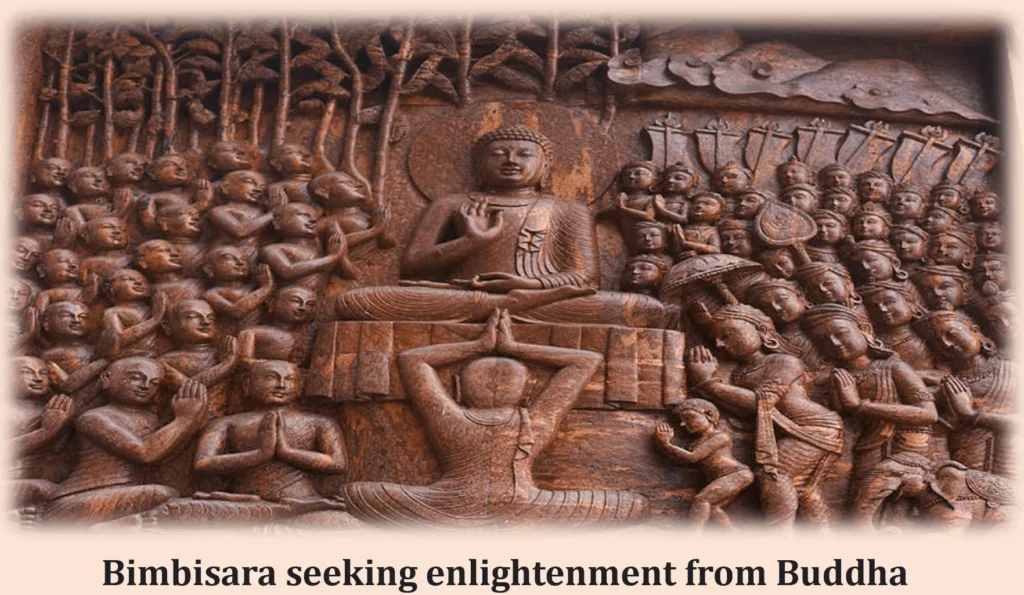
Magadha as a Mahajanapada holds religious and cultural importance. Its contribution to the dissemination of Buddhism, its military and political prowess and its advancements in education and academia have greatly influenced history. The impact of Magadha’s legacy can be seen not in Indian history but also, in the wider cultural and religious heritage of the region.
Mahajanpadas and foreign powers
The ancient Mahajanapadas of India were not immune to foreign invasions, and their history includes various instances of external incursions that affected their political, social, and cultural fabric. These invasions often had a significant impact on the Mahajanapadas, and some of the key foreign invasions include:
Alexander the Great’s Invasion (326 BCE)
One of the known instances of foreign incursions was Alexander the Greats expedition, in 326 BCE. While Alexander didn’t penetrate into India his troops crossed the regions of the Indian subcontinent by passing through Kyber Pass in 326 BCE. All the kings meekly submitted to him but it only Porus who gave a tough resistance to Alexander in the Battle of Hydaspas(on Jhelum). Although, Porus was defeated but Alexander had to retreat as his soldiers refused to proceed due to fatigue. He erected 12 huge stone alters to mark his advancement. His invasion marked the first known contact between the Hellenistic world and the Indian subcontinent.
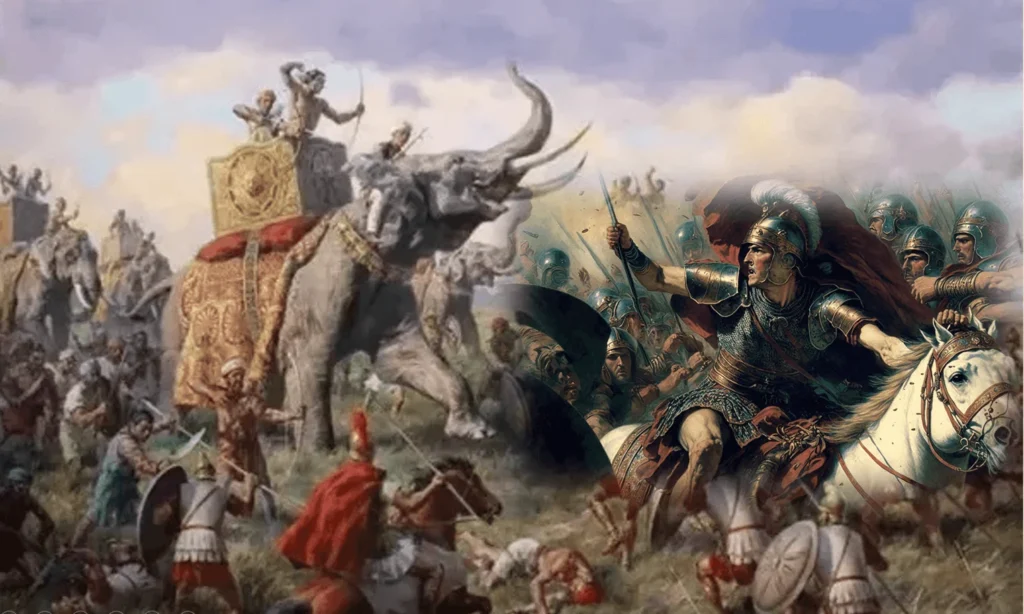
The Invasion of the Indo-Greeks
Following Alexander’s campaign, there were later incursions by the Indo-Greeks. They established small kingdoms in northwestern India, combining Greek and Indian cultural elements. The Indo-Greek rulers, such as Menander, ruled in parts of the northwestern Mahajanapadas.
The Invasion of the Scythians and the Indo-Parthians
During the centuries CE there was a migration of nomadic tribes and groups such, as the Scythians and Indo Parthians, into northwestern India. They established their rule in regions previously under the control of Indian Mahajanapadas. These foreign rulers interacted with the local population and adopted some aspects of Indian culture.
The Invasion of the Kushans
During the 1st century CE, the Kushans, a group of people, from Central Asia launched an invasion. Established their empire in northwestern India. Their presence had an impact, on both the cultural aspects of the region. The Kushan Empire included regions previously belonging to Mahajanapadas such as Gandhara.
The Hun Invasions
In the 5th and 6th centuries CE a group called the Hephthalites, who were also known as the White Huns launched an invasion into India and certain regions of the Gangetic plains. Their invasions disrupted the established political order and contributed to the decline of some Mahajanapadas. The Huns were eventually repelled, but their invasions left a lasting impact on the region.
Islamic Invasions
From the century CE the course of Indian history took a notable turn, with the Islamic invasions. The arrival of later Turkic forces introduced Islam to the subcontinent and resulted in the rise of different Islamic dynasties and empires. The Islamic rulers gradually expanded their control over several Mahajanapadas and other Indian territories.
Throughout history the arrival of forces has frequently resulted in the assimilation of cultural, religious and political elements, into Indian society. This has greatly influenced the diverse nature of the subcontinent’s history. Despite being challenging these invasions have also played a role, in shaping Indias trajectory and the emergence of subsequent empires and dynasties.
The Arthashastra and Kautilya’s Role
The “Arthashastra” is an ancient Indian treatise on statecraft, economic policy, and military strategy, traditionally attributed to the scholar and statesman Kautilya, also known as Chanakya. It is a foundational work on political science and governance in India. The “Arthashastra” provides valuable insights into the administration and management of Mahajanapadas, among other aspects of ancient Indian polity. Here’s an overview of the “Arthashastra” and Kautilya’s role in the context of Mahajanapadas:

Authorship and Historical Context
The authorship of the “Arthashastra” is attributed to Kautilya, who held the position of chief minister and advisor, to Chandragupta Maurya, the visionary behind the establishment of the Mauryan Empire, in times. At that time India had Mahajanapadas as entities and the Mauryan Empire was expanding its influence over them. Kautilya’s contributions were vital in this period as he played a role, in shaping and strengthening the Mauryan Empire.
Role in Administration
Kautilya’s “Arthashastra” provides detailed guidelines for the administration of a state. It addresses aspects such as taxation, law enforcement, foreign policy, and governance. The text lays out a comprehensive framework for how a ruler should manage his kingdom efficiently, including the Mahajanapadas that were under his control.
Economic Policies
The “Arthashastra” provides insights, into strategies encompassing areas such, as agriculture, trade and taxation. It highlights the significance of an economy in ensuring the stability and advancement of a kingdom. Kautilya’s ideas on resource management and revenue collection were vital for governing the Mahajanapadas effectively.
Foreign Policy and Military Strategy
One of the notable aspects of the “Arthashastra” is its detailed treatment of foreign policy and military strategy. It provides strategies for diplomacy, espionage, alliances, and warfare. Given the competition and conflicts among Mahajanapadas, the text’s guidance on handling external relations and security issues was invaluable.
Moral and Ethical Considerations
Kautilya’s “Arthashastra” does not shy away from advocating ruthless and pragmatic strategies in statecraft. It is known for its realpolitik approach and often highlights the need for a ruler to be both cunning and ethical in governance. The text acknowledges that morality and ethics are essential components of a ruler’s toolkit in managing his kingdom.
Kautilya’s Impact on the Mauryan Empire
Kautilya’s counsel and the principles outlined in the “Arthashastra” played a significant role in the rise and consolidation of the Mauryan Empire. Chandragupta Maurya, with Kautilya’s guidance, successfully expanded his empire and controlled a vast territory, including several Mahajanapadas. This marked a pivotal moment in ancient Indian history, as it saw the unification of numerous Mahajanapadas under a single imperial authority.
Kautilya’s “Arthashastra” and his role as a political advisor were instrumental in shaping the administration and governance of Mahajanapadas, especially during the time of the Mauryan Empire. The treatise provided a comprehensive guide for rulers on how to manage their territories, conduct foreign affairs, and ensure the prosperity and stability of their realms. Kautilya’s influence on the Mauryan Empire’s expansion and consolidation further underscored the enduring significance of his ideas in the history of ancient India.
Economy of Mahajanpadas
The 6th century BC was marked by growth and proliferation of large number of cities. This phase of urbanization is known as the second urbanization, marked by the abundant production of rice. Such production enabled large section of people to divert towards non-farming activities leading to proper urbanization.
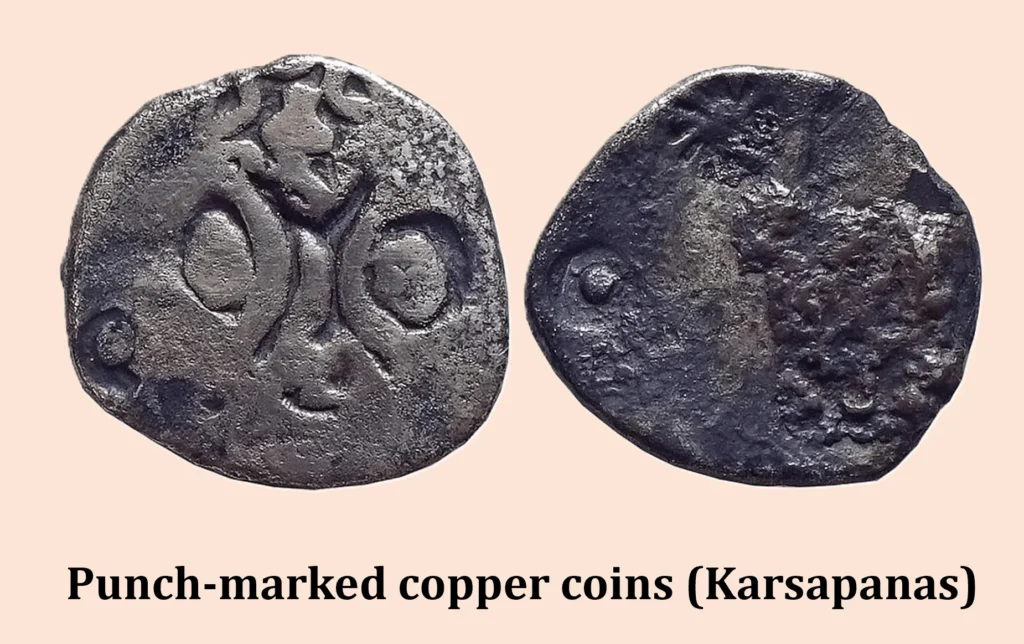
This urbanization was accompanied by currency and coinage as first coin begin to be circulated as the punch-marked coins. These coins made from copper were also known as Karsapanas. The flourishing trade led to the emergence of merchant association, or guilds, who began to practice of lending money on interest. All such development could not get reconciled with Vedic practices which was marked by cattle sacrifice, reliance on agriculture and prohibition of lending money on interest.
Conclusion
To sum up, the Mahajanapadas are an important part of the intricate history of ancient India. The sixteen vast kingdoms and republics that once ruled the Indian subcontinent served as the impetus for the rise of strong dynasties and empires. Their contributions to politics, culture, and religion have permanently altered India’s past.
Moreover, by this time the Varna divided society began to generate internal tensions as Kshatriyas were not ready to accept the second slot in social hierarchy. Even Vaishyas wanted liberal religion to promote economic activities. It is not a surprise that the founder of two heterodox religion, Buddhism and Jainism belonged to the Kshatriya community.
The rise and fall of these Mahajanapadas reflect the dynamic nature of ancient India, where the constant interaction between diverse states and societies shaped the course of history. From Magadha’s imperial ambitions to Kashi’s spiritual significance, and from Vatsa’s scholarly endeavors to Avanti’s cultural contributions, the Mahajanapadas provide us with a compelling narrative of a bygone era. Exploring their stories helps us better understand the origins of India’s complex and multifaceted history, which continues to be a source of fascination and study for scholars and enthusiasts alike.
